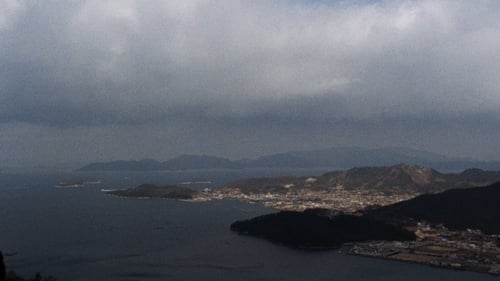We Need to Talk About A.I. (2020)
Genre : Documentary
Runtime : 1H 26M
Director : Leanne Pooley
Synopsis
Conflict between man and machine has been a science fiction staple for over a century. From 2001: A Space Odyssey to The Terminator the perceived threat posed by super-intelligent robots has been exploited by Hollywood for decades. But do advances in Artificial Intelligence mean we are now facing a future in which that threat could become a reality?

We live in a new age. We are always rushing, rushing for no reason, rushing for nothing. As though time had sped up. Everything implies speed, urgency. But ultimately, why does time seem so short? This film is about the director’s conflict about time and the lack of it in today’s world; she reflects on civilization and the future of existence.

In 1971, author and film scholar Donald Richie published a poetic travelogue about his explorations of the islands of Japan’s Inland Sea, recording his search for traces of a traditional way of life as well as his own journey of self-discovery. Twenty years later, filmmaker Lucille Carra undertook a parallel trip inspired by Richie’s by-then-classic book, capturing images of hushed beauty and meeting people who still carried on the fading customs that Richie had observed. Interspersed with surprising detours—a visit to a Frank Sinatra–loving monk, a leper colony, an ersatz temple of plywood and plaster—and woven together by Richie’s narration as well as a score by celebrated composer Toru Takemitsu, The Inland Sea is an eye-opening voyage and a profound meditation on what it means to be a foreigner.

The Inner and Outer World of Shahrukh Khan is the release title for a pair of documentaries about Bollywood superstar Shahrukh Khan, both directed by the London-based writer and producer/director Nasreen Munni Kabir, an authority on Hindi cinema.

A story about greed, politics and the land grab of the century, ZIPPER chronicles the battle over an American cultural icon. Small-time ride operator, Eddie Miranda, proudly operates a carnival contraption called the Zipper in the heart of Coney Island's gritty amusement district. When his rented lot is snatched up by a real estate mogul, Eddie and his ride become casualties of a power struggle between the developer and the City of New York over the future of the world-famous destination. Be it an affront to history or simply the path of progress, the spirit of Coney Island is at stake. In an increasingly corporate landscape, where authenticity is often sacrificed for economic growth, the Zipper may be just the beginning of what is lost.

Following their triumph with Manufactured Landscapes, photographer Edward Burtynsky and filmmaker Jennifer Baichwal reunite to explore the ways in which humanity has shaped, manipulated and depleted one of its most vital and compromised resources: water.

The Same Difference is a documentary about lesbians who discriminate against other lesbians! The Same Difference, through a series of lesbian women stories, discusses the hypocrisy in terms of gender roles and the per formative expectations.

How did Hollywood pitch movies about gays and lesbians between 1956 and 1977? Here are theatrical trailers for 27 mainstream and art-house films, presented chronologically from "Tea and Sympathy" to "Outrageous!" More than half are films released between 1968 and 1972. Half are dramas and half are comedies, with farce dominating the films released after 1971. At least three advertise X-rated films: "The Killing of Sister George," "Midnight Cowboy," and Visconti's "The Damned." There's no voice-over commentary for this compilation, but it does include advertisements for snacks and one warning against public displays of affection aimed at "her" to control "him."

Emboldened by a giant block party on the evening of their high school prom, a group of students enter the night with the hope of transcending their rural town and the industrial landscape that surrounds them.

Since the late 18th century American legal decision that the business corporation organizational model is legally a person, it has become a dominant economic, political and social force around the globe. This film takes an in-depth psychological examination of the organization model through various case studies. What the study illustrates is that in the its behaviour, this type of "person" typically acts like a dangerously destructive psychopath without conscience. Furthermore, we see the profound threat this psychopath has for our world and our future, but also how the people with courage, intelligence and determination can do to stop it.

A follow up to award winning documentary 'Herb & Dorothy', the film captures the ordinary couple's extraordinary gift of art to the nation as they close the door on their life as collectors. When Herb and Dorothy Vogel, a retired postal clerk and librarian, began collecting works of contemporary art in the 1960s, they never imagined it would outgrow their one bedroom Manhattan apartment and spread throughout America. 50 years later, the collection is nearly 5,000 pieces and worth millions. Refusing to sell, the couple launches an unprecedented gift project giving artworks to one museum in all 50 states. The film journeys around the country with the Vogels, meeting artists who are famous or unknown, often controversial, striking today's society with questions about art and its survival.

In the Landes de Gascogne forest, bird cages are hoisted up to the tree tops with pulleys. A man on watch in a large low hut camouflaged by pine needles awaits the opportune moment to pull the strings. A strange and fascinating woodland theatre... Bucking all commentary, Marine de Contes depicts a practice in all its ritualistic complexity.

A deep look at the class warfare and the contradictions that African-Americans face within their own community when many of them are ostracized because they are “not black enough.” An analysis of the reasons behind these absurd acts of hatred.

From dreamy aerial opening shots, we are sent on an expedition through the storied land of our fifth most populous state, Illinois, often called a miniature version of America. Deborah Stratman’s experimental documentary explores how physical landscapes and human politics can each re-interpret historical events. Eleven parables relay histories of settlement, removal, technological breakthrough, violence, messianism, and resistance. Who gets to write history—physical monuments, official news accounts, or personal spoken-word memories?

The unfinished documentary about the making of Dennis Hopper's mostly unseen feature film The Last Movie (1971).

'A Walk to Within: The Camino de Santiago' tells the story of walking the ancient 500-mile pilgrimage across norther Spain known as 'The Camino de Santiago'. The documentary follows six strangers from incredibly diverse walks of life as they attempt to cross an entire country on foot with only a backpack, a pair of boots, and an open mind. Each pilgrim throws themselves heart-and-soul into their physical trek to Santiago de Compostela, and their personal journey to themselves. As you watch, you will learn the rich history of this honored tradition, as well as witness the Camino's remarkable ability to change lives and provide those who choose to walk its paths with a greater sense of self and spiritual knowledge.

Hundreds of excerpts from 60 French films produced by the NFB over the course of 50 years are assembled to offer a look at the evolution of how women have been portrayed on film.

An electrifying portrait of a young artist determined to live life on his own terms. Born Rashard Bradshaw, Cakes Da Killa is a 22 year old hip hop artist. As an openly gay man he is not your run of the mill rapper, but he just might be your new favorite.

Two young women used their own body as a war weapon by participating in a hunger strike in the Turkish prisons in the year 2000. This hunger strike was repressed in a bloody way by the army. Between portraits and archives images, a reflection on the resistance and the sacrifice of the individual in front of the violence of the State.

The remarkable story of how 13 amateur female golfers fought to form the LPGA in 1950. With the odds stacked against them, they made history.












